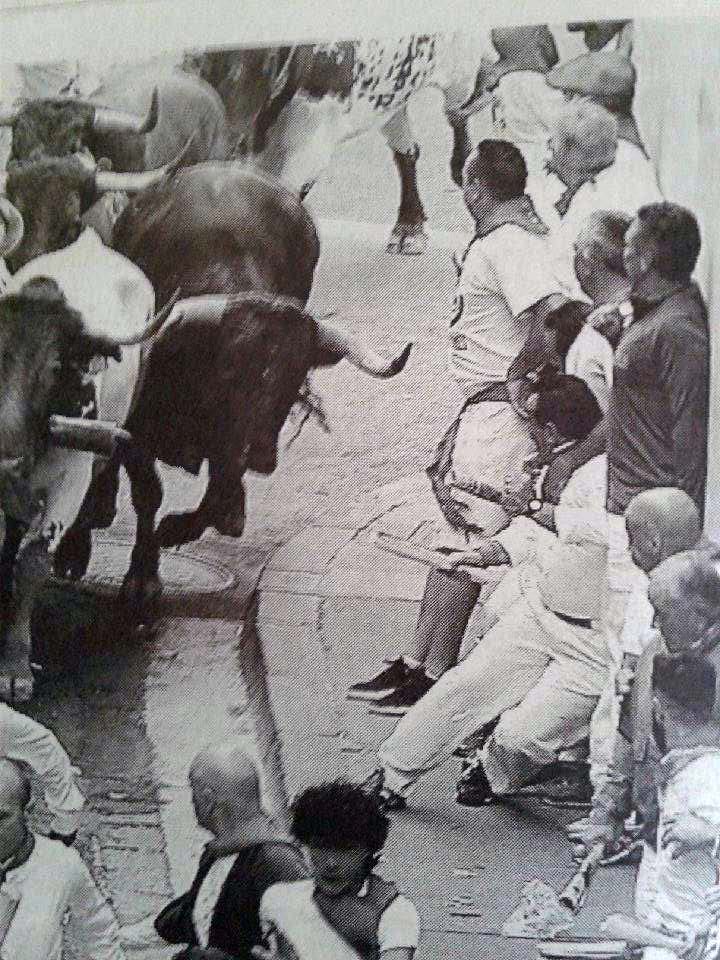Why I am still bullish on Pamplona's big fiesta.
The Running of the Bulls, as we Americans know it, lives up to every description and much more. Now I will experience the fiesta post-pandemic.
Sometimes travelers wander into cities by accident. But I know exactly why I came to Pamplona that first year back in 1976. I came to run the bulls.
I drove for two days to see if the legendary fiesta was as wild as James Michener made it sound in his chapter set in Pamplona during San Fermin in "The Drifters."
The Running of the Bulls, as we Americans know it, or Fiesta de San Fermin, as it is known throughout Spain, lived up to every description and much more — more than I could even imagine. This town, at the foothills of the Pyrenees, for eight or ten days in July (depending on how you counted ... and how long you lasted) became the center of the let-it-all-hang-out, free-love lifestyle of the '60s and '70s.
Every day we lived life to its fullest. Rough red country wine alternating with champagne passed from reveler to reveler in bottles and botas. Streets and plazas were packed shoulder-to-shoulder with nonstop dancers swaying behind peña bands every hour in darkness or in the harsh light of day.
In bars, eyes would meet across the room; lips formed words impossible to hear over the din but clearly understood; and one-time strangers found themselves arm in arm embracing momentary best friends and, possibly, new lovers.
Every morning we faced death. We gathered in the narrow streets and waited to sprint in front of six half-ton fighting bulls and seven steers barreling up the cobblestones at 8 o'clock on their way to the arena and their destiny.
On my first morning in the streets, I didn't even know from what direction the bulls would come. I quickly figured it out. Diving down to the sidewalk and only getting up when a Spaniard tapped me on the shoulder, I never felt so good for having been missed.
Pamplona was a perfect balance of unvarnished life, exuberance, and possible death.
Lifetimes were lived in hours. Inhibitions fell to the wayside. Smiling was the only way of life. For my days there, this was life in another world.
But that was 45 years ago. That was in the days of bellbottoms. That was immediate post-Vietnam. That was post-pill, but pre-AIDS. That was under the still persisting rules of Franco's Spain.
The biggest surprise is that today in Pamplona during San Fermin, the exuberance is still much the same. Amazing but true, the essence of the fiesta hasn't changed. The Pamplona of Hemingway in the '30s and that of Michner in the '60s and the fiesta that we find in the 2000s is still the ultimate celebration of life.
Chance meetings still grow into lifelong friendships.
Eyes still meet slowly across crowded rooms. Dancing crowds follow peña bands, still playing those same fiesta songs down centuries-old narrow streets. Sleep is still at a premium. Thousands still dare death each morning. And that feeling of having defied death still makes the hair stand up on the back of my neck.
The youthful stupor of too much rough wine has been replaced by the pleasant sustained buzz of just enough Rioja wine. I don't camp out anymore — I rent an apartment. I make sure to eat at least two good meals a day. But I still dance in the streets, still get far too little sleep and still find my way into the streets every morning and wait uncertainly for that sure adrenaline rush as wild bulls race my way.

Why do I go back to Pamplona year after year?
Bullfights can be found in scores of other Spanish towns and processions are a way of life in Spain. People dance everywhere and bands play throughout the world. But in this fortress city in the foothills of the Pyrenees, these elements combine with the diverse personalities of people from across the world to create an addictive atmosphere.
The magic of this fiesta is the virtual suspension of time combined with a chance to live life minute-by-minute once one is swept into the unique world of Fiesta. It is this altered state that makes this festival truly unique and why I return religiously.
San Fermin still has the ability, unique in the world, to concentrate a lifetime into minutes. Here we focus on what is important in the moment. In this modern world, it is a rare experience.
Come to Fiesta in Pamplona for more than a couple of days.
If you come for only a couple of days, you have merely a chance to observe the festivities. You need more time to let the noise from the outside world leave you. Only then can you become part of the celebration and wallow in the wonderful fiesta amity. The difference between observing happiness and abandoning yourself to joy is life-changing.
As a raven-haired Spanish girl once told me more than forty-something years ago, "Pamplona and San Fermin can not be explained, they can only be experienced."
I believe that San Fermin in Pamplona is still one of the few places in the world that makes it easy to take that step, year after year, from restrained spectator to total participant.
Charlie Leocha
Charlie Leocha is the President of Travelers United. He has been working in Washington, DC, for the past 14 years with Congress, the Department of Transportation, and industry stakeholders on travel issues. He was the first consumer representative to the Advisory Committee for Aviation Consumer Protections appointed by the Secretary of Transportation from 2012 through 2018.









Charlie,
This sounds like a nightmare to me . . .yikes! Emulating Hemingway can be dangerous! Please don't come home in a body bag.